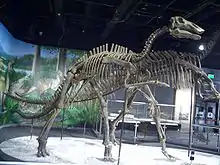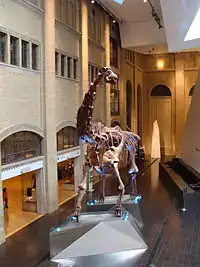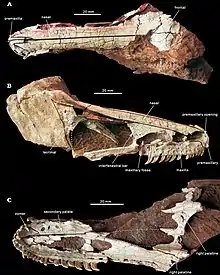Coniacian
The Coniacian is an age or stage in the geologic timescale. It is a subdivision of the Late Cretaceous epoch or Upper Cretaceous series and spans the time between 89.8 ± 1 Ma and 86.3 ± 0.7 Ma (million years ago). The Coniacian is preceded by the Turonian and followed by the Santonian.[2]
| Coniacian | |
|---|---|
| 89.8 ± 0.3 – 86.3 ± 0.5 Ma | |
| Chronology | |
Key events in the Cretaceous -140 — – -130 — – -120 — – -110 — – -100 — – -90 — – -80 — – -70 — – An approximate timescale of key Cretaceous events. Axis scale: millions of years ago. | |
| Etymology | |
| Name formality | Formal |
| Usage information | |
| Celestial body | Earth |
| Regional usage | Global (ICS) |
| Time scale(s) used | ICS Time Scale |
| Definition | |
| Chronological unit | Age |
| Stratigraphic unit | Stage |
| Time span formality | Formal |
| Lower boundary definition | Not formally defined |
| Lower boundary definition candidates | FAD of the Inoceramid Bivalve Cremnoceramus rotundatus |
| Lower boundary GSSP candidate section(s) |
|
| Upper boundary definition | FAD of the Inoceramid Bivalve Cladoceramus undulatoplicatus |
| Upper boundary GSSP | Olazagutia, Spain 42.8668°N 2.1968°W |
| GSSP ratified | January 2013[1] |
Stratigraphic definitions
The Coniacian is named after the city of Cognac in the French region of Saintonge. It was first defined by French geologist Henri Coquand in 1857.
The base of the Coniacian stage is at the first appearance of the inoceramid bivalve species Cremnoceramus rotundatus. An official reference profile for the base (a GSSP) had in 2009 not yet been appointed.
The top of the Coniacian (the base of the Santonian stage) is defined by the appearance of the inoceramid bivalve Cladoceramus undulatoplicatus.
The Coniacian overlaps the regional Emscherian stage of Germany, which is roughly coeval with the Coniacian and Santonian stages. In magnetostratigraphy, the Coniacian is part of magnetic chronozone C34, the so-called Cretaceous Magnetic Quiet Zone, a relatively long period with normal polarity.
Sequence stratigraphy and geochemistry
After a maximum of the global sea level during the early Turonian, the Coniacian was characterized by a gradual fall of the sea level. This cycle is in sequence stratigraphy seen as a first order cycle. During the middle Coniacian a shorter, second order cycle, caused a temporary rise of the sea level (and global transgressions) on top of the longer first order trend. The following regression (Co1, at 87,0 Ma) separates the Middle from the Upper Coniacian substage. An even shorter third order cycle caused a new transgression during the Late Coniacian.
Beginning in the Middle Coniacian, an anoxic event (OAE-3) occurred in the Atlantic Ocean, causing large scale deposition of black shales in the Atlantic domain. The anoxic event lasted till the Middle Santonian (from 87.3 to 84.6 Ma) and is the longest and last such event during the Cretaceous period.[3]
Subdivision
The Coniacian is often subdivided into Lower, Middle and Upper substages. It encompasses three ammonite biozones in the Tethys domain:
- zone of Paratexanites serratomarginatus
- zone of Gauthiericeras margae
- zone of Peroniceras tridorsatum
In the boreal domain the Coniacian overlaps just one ammonite biozone: that of Forresteria petrocoriensis
Palaeontology
†Ornithischians
| †Ornithischians of the Coniacian | ||||
|---|---|---|---|---|
| Taxa | Presence | Location | Description | Images |
| Turonian to Coniacian | Gobi Desert, Mongolia and China | Would have been 6 m (20 ft) long and 2 m (7 ft) high when in the quadrupedal stance, and weighed 1100 – 1500 kg (2400 - 3300 lb). Like many hadrosaurs, it could switch between bipedal and quadrupedal stances, but unusually it had large spines protruding from the vertebrae. | ||
| Turonian to early Coniacian | Portezuelo Formation, Argentina | A genus of basal iguanodont, a large bipedal herbivore | ||
†Sauropods
| †Sauropods of the Coniacian | ||||
|---|---|---|---|---|
| Taxa | Presence | Location | Description | Images |
| Futalognkosaurus | Coniacian | Portezuelo Formation, Argentina | The type species, Futalognkosaurus dukei, is estimated to be between 26 and 30 m in length, rivaling the gigantic Argentinosaurus. Its long neck contained 14 vertebrae, and was over a meter deep in places, due to its extremely tall neural spines which had a distinctive "shark-fin" shape. The hips were also extremely large and bulky, reaching a width of nearly 3 metres (9.8 ft).[4] The alternate early spelling "Futalongkosaurus" may be found in some press reports and on websites. | |
| Mendozasaurus | Coniacian | Mendoza Formation, Argentina | Close relative of Futalognkosaurus, it had a heavy neck and high neural spines. | |
†Plesiosaurs
| †Plesiosaurs of the Coniacian | ||||
|---|---|---|---|---|
| Taxa | Presence | Location | Description | Images |
| Coniacian | Trichinopoly Group, India | A small plesiosaur of undeterminate length. | ||
References
Notes
- Lamolda, M.; Paul, C.; Peryt, D.; Pons, J. (March 2014). "The Global Boundary Stratotype and Section Point (GSSP) for the base of the Santonian Stage, "Cantera de Margas", Olazagutia, northern Spain". Episodes. 37 (1): 2–13. doi:10.18814/epiiugs/2014/v37i1/001. Retrieved 24 December 2020.
- See Gradstein et al. (2004) for a detailed version of the ICS' geologic timescale
- See Meyers et al. (2006)
Literature
- Gradstein, F.M.; Ogg, J.G. & Smith, A.G.; 2004: A Geologic Time Scale 2004, Cambridge University Press.
- Meyers, P.A.; Bernasconi, S.M. & Forster, A.; 2006: Origins and accumulation of organic matter in expanded Albian to Santonian black shale sequences on the Demerara Rise, South American margin, Organic Geochemistry 37, pp 1816–1830.
External links
- GeoWhen Database - Coniacian
- Late Cretaceous timescale, at the website of the subcommission for stratigraphic information of the ICS
- Stratigraphic chart of the Late Cretaceous, at the website of Norges Network of offshore records of geology and stratigraphy


